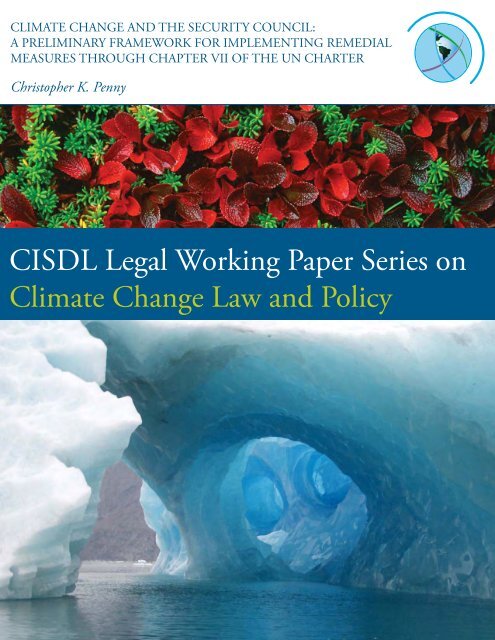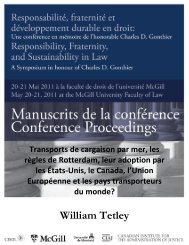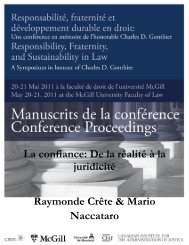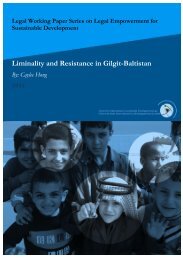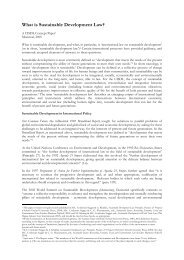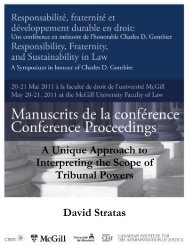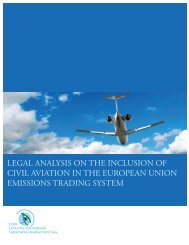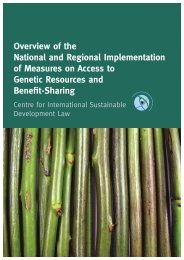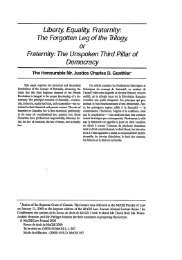Climate Change and the Security Council - CISDL
Climate Change and the Security Council - CISDL
Climate Change and the Security Council - CISDL
You also want an ePaper? Increase the reach of your titles
YUMPU automatically turns print PDFs into web optimized ePapers that Google loves.
CLIMATE CHANGE AND THE SECURITY COUNCIL:<br />
A PRELIMINARY FRAMEWORK FOR IMPLEMENTING REMEDIAL<br />
MEASURES THROUGH CHAPTER VII OF THE UN CHARTER<br />
Christopher K. Penny<br />
<strong>CISDL</strong> Legal Working Paper Series on<br />
<strong>Climate</strong> <strong>Change</strong> Law <strong>and</strong> Policy
CLIMATE CHANGE AND THE SECURITY COUNCIL:<br />
A PRELIMINARY FRAMEWORK FOR<br />
IMPLEMENTING REMEDIAL MEASURES THROUGH<br />
CHAPTER VII OF THE UN CHARTER<br />
A <strong>CISDL</strong> WORKING PAPER<br />
Christopher K. Penny*<br />
________________________________________________________________________________________<br />
* B.A.(Hon.), LL.B., M.A., LL.M. Assistant Professor of International Law, Norman Paterson School of<br />
International Affairs, Carleton University, Ottawa, Ontario, Canada.
The Centre for International Sustainable Development Law (<strong>CISDL</strong>) is a legal research centre,<br />
based in <strong>the</strong> McGill University Faculty of Law, which works in cooperation with <strong>the</strong> Université<br />
de Montreal Faculty of Law, <strong>and</strong> <strong>the</strong> Université de Québec à Montreal. Its mission is to promote<br />
sustainable societies <strong>and</strong> <strong>the</strong> protection of ecosystems by advancing <strong>the</strong> underst<strong>and</strong>ing,<br />
development <strong>and</strong> implementation of international sustainable development law. <strong>CISDL</strong> is led by<br />
two directors <strong>and</strong> eight lead counsel or research fellows, receives guidance from <strong>the</strong> three<br />
Montreal-based treaty secretariats (<strong>the</strong> NAFTA Commission for Environmental Cooperation, <strong>the</strong><br />
UNEP Biodiversity Convention, <strong>and</strong> <strong>the</strong> Montreal Protocol multilateral fund), <strong>and</strong> has an<br />
international council of sustainable development legal <strong>and</strong> policy experts, <strong>and</strong> a roster of<br />
distinguished international advisors. A Sustainable Development Law International Jurists<br />
M<strong>and</strong>ate <strong>and</strong> <strong>the</strong> main <strong>CISDL</strong> Legal Research Agendas, of which climate change law is one,<br />
were officially launched at Sustainable Justice 2002: Implementing International Sustainable<br />
Development Law conference in Montreal, Canada, <strong>and</strong> <strong>CISDL</strong>’s flagship publication, ‘Weaving<br />
<strong>the</strong> Rules of Our Common Future’ was later launched at <strong>the</strong> World Summit for Sustainable<br />
Development in Johannesburg, South Africa.<br />
This document is printed on recycled paper.<br />
Contact Information:<br />
<strong>CISDL</strong> Directors:<br />
Marie-Claire C. Segger<br />
Director, email: MCSegger@iisd.ca / marieclaire@cisdl.org<br />
Ashfaq Khalfan<br />
Director, email: AKhalfan@cisdl.org<br />
Chair of <strong>the</strong> <strong>CISDL</strong> Board of Governors:<br />
Hon. Judge Charles D. Gonthier<br />
Faculty of Law, McGill University<br />
3661 Peel Ave, Montreal<br />
Quebec, Canada<br />
Tel 001 514 398 6604<br />
Fax 001 514 398 4659
CLIMATE CHANGE AND THE SECURITY COUNCIL:<br />
A PRELIMINARY FRAMEWORK FOR IMPLEMENTING<br />
REMEDIAL MEASURES THROUGH CHAPTER VII OF THE UN<br />
CHARTER<br />
A <strong>CISDL</strong> WORKING PAPER<br />
1. Introduction<br />
2. <strong>Climate</strong> <strong>Change</strong> as an Emerging ‘Threat to International Peace <strong>and</strong> <strong>Security</strong>’<br />
2.1 <strong>Security</strong> Implications of <strong>Climate</strong> <strong>Change</strong><br />
2.2 <strong>Security</strong> <strong>Council</strong> Authority to Address <strong>Climate</strong> <strong>Change</strong><br />
3. A Preliminary Framework for <strong>the</strong> Implementation of Remedial Measures<br />
3.1 Legal Authority<br />
3.2 An Environmental <strong>Security</strong> Committee<br />
4. Conclusions
1. Introduction<br />
International cooperation, state compliance, <strong>and</strong> policy coherence are necessary elements in any<br />
strategy to address <strong>and</strong> mitigate <strong>the</strong> clear global threat posed by climate change. The 2005 entryinto<br />
force of <strong>the</strong> Kyoto Protocol 1 marked a significant step towards achieving <strong>the</strong>se goals,<br />
building on general principles established in <strong>the</strong> 1992 Framework Convention. 2 Ongoing<br />
international efforts, including <strong>the</strong> 2005 COP11/MOP1 in Montreal, may fur<strong>the</strong>r streng<strong>the</strong>n <strong>and</strong><br />
exp<strong>and</strong> this regime. However, despite <strong>the</strong>se important developments, <strong>the</strong> continuing inadequacy<br />
of current responses to climate change suggests that voluntary measures alone may not be<br />
sufficient to meet this challenge. Recognizing this possibility, <strong>the</strong> following <strong>CISDL</strong> working<br />
paper assesses <strong>the</strong> potential for <strong>the</strong> United Nations [UN] to require states to cooperate to address<br />
<strong>the</strong> causes of climate change, proposing a preliminary framework for <strong>the</strong> coherent<br />
implementation of global remedial measures. 3<br />
This paper explores institutional mechanisms available to <strong>the</strong> <strong>Security</strong> <strong>Council</strong> to combat climate<br />
change, building upon arguments that <strong>the</strong> application of Chapter VII enforcement measures to<br />
address this threat falls within its jurisdiction as established in <strong>the</strong> UN Charter. 4 Part 2<br />
summarizes arguments establishing <strong>Security</strong> <strong>Council</strong> legal authority to address climate change as<br />
a ‘threat to international peace <strong>and</strong> security,’ followed in Part 3 by a discussion of <strong>the</strong> remedial<br />
mechanisms available to this institution following any such characterization. This analysis<br />
demonstrates that <strong>the</strong> establishment of a subordinate Environmental <strong>Security</strong> Committee to<br />
monitor <strong>and</strong> facilitate state implementation of m<strong>and</strong>atory legislative measures to combat <strong>the</strong><br />
causes of climate change would be consistent with accepted underst<strong>and</strong>ings of <strong>Security</strong> <strong>Council</strong><br />
1<br />
Kyoto Protocol to <strong>the</strong> United Nations Framework Convention on <strong>Climate</strong> <strong>Change</strong>, (1998) 37 I.L.M. 22 [Kyoto<br />
Protocol].<br />
2<br />
United Nations Framework Convention on <strong>Climate</strong> <strong>Change</strong>, (1992) 31 I.L.M. 849 [Framework Convention].<br />
3<br />
This paper nei<strong>the</strong>r advocates nor foresees <strong>the</strong> immediate adoption of Chapter VII remedial measures by <strong>the</strong><br />
<strong>Security</strong> <strong>Council</strong> through this framework. In fact, a workable legal <strong>and</strong> institutional framework is a necessary but<br />
not sufficient precondition for <strong>the</strong> <strong>Security</strong> <strong>Council</strong> to implement effective remedial measures. Establishing <strong>and</strong><br />
maintaining <strong>the</strong> political will to invoke Chapter VII authority <strong>and</strong> impose any such mechanism, <strong>and</strong> to ensure<br />
continued practical state support, is a crucial additional element. Although <strong>the</strong>se political issues are beyond <strong>the</strong><br />
scope of <strong>the</strong> current paper, it is clear that voluntary mechanisms can <strong>and</strong> should be attempted first, recognizing that<br />
without first streng<strong>the</strong>ning state acceptance of remedial climate change measures any m<strong>and</strong>atory implementation by<br />
<strong>the</strong> <strong>Security</strong> <strong>Council</strong> would be premature <strong>and</strong> likely ineffective. However, in <strong>the</strong> event that voluntary mechanisms<br />
prove insufficient to stem <strong>the</strong> causes of climate change, it is important to underst<strong>and</strong> <strong>the</strong> authority available to <strong>the</strong><br />
<strong>Security</strong> <strong>Council</strong> to require state action <strong>and</strong> <strong>the</strong> manner in which it might be implemented. This paper seeks to<br />
initiate discussion of this issue, with <strong>the</strong> long-term goal of developing an institutional framework to respond to this<br />
emerging threat in a rational <strong>and</strong> methodical manner, if <strong>and</strong> when required.<br />
4<br />
Charter of <strong>the</strong> United Nations, 26 June 1945, Can. T.S. 1945 No. 7 [UN Charter]. Unless<br />
o<strong>the</strong>rwise indicated, all references to Articles or Chapters refer to provisions of <strong>the</strong> UN Charter.
5<br />
authority. 5<br />
2. <strong>Climate</strong> <strong>Change</strong> as an Emerging ‘Threat to International<br />
Peace <strong>and</strong> <strong>Security</strong>’<br />
This Part outlines <strong>the</strong> practical <strong>and</strong> legal basis for addressing climate change as a threat falling<br />
within <strong>the</strong> jurisdiction of <strong>Security</strong> <strong>Council</strong>. Following a brief overview of <strong>the</strong> projected security<br />
implications of climate change, this Part summarizes legal arguments supporting its future<br />
characterization by <strong>the</strong> <strong>Security</strong> <strong>Council</strong> as a ‘threat to international peace <strong>and</strong> security’. 6<br />
2.1 <strong>Security</strong> Implications of <strong>Climate</strong> <strong>Change</strong><br />
There is little scientific disagreement that climate change is occurring <strong>and</strong> will continue for <strong>the</strong><br />
foreseeable future, although estimates vary concerning its extent <strong>and</strong> severity. 7 While this is an<br />
obvious environmental concern, it will also have significant security implications. The projected<br />
consequences of climate change, direct <strong>and</strong> indirect, pose clear <strong>and</strong> recognized threats both to<br />
individual well-being <strong>and</strong> to <strong>the</strong> maintenance of international peace <strong>and</strong> stability. 8 Although<br />
<strong>the</strong>se challenges have not yet fully materialized, this does not mean that <strong>the</strong> overall threat posed<br />
5<br />
This paper summarizes <strong>and</strong> exp<strong>and</strong>s upon arguments outlined in Christopher K. Penny, “Greening <strong>the</strong> <strong>Security</strong><br />
<strong>Council</strong>: <strong>Climate</strong> <strong>Change</strong> as an Emerging ‘Threat to International Peace <strong>and</strong> <strong>Security</strong>’,” Fragmentation:<br />
Diversification <strong>and</strong> Expansion of International Law, 2005 Canadian <strong>Council</strong> on International Law Conference<br />
Proceedings (Ottawa: CCIL, 2006) [publication forthcoming].<br />
6<br />
The remedial mechanisms available to <strong>the</strong> <strong>Security</strong> <strong>Council</strong> following such a characterization are analysed in Part<br />
III, below.<br />
7<br />
A 2005 report of <strong>the</strong> Secretary-General underscored <strong>the</strong> threat posed by climate change, arguing that:<br />
[o]ne of <strong>the</strong> greatest environmental <strong>and</strong> development challenges in <strong>the</strong> twenty-first century will be<br />
that of controlling <strong>and</strong> coping with climate change. The overwhelming majority of scientists now<br />
agree that human activity is having a significant impact on <strong>the</strong> climate. Since <strong>the</strong> advent of <strong>the</strong><br />
industrial era in <strong>the</strong> mid-eighteenth century, atmospheric concentrations of greenhouse gases have<br />
increased significantly, <strong>the</strong> earth has warmed considerably <strong>and</strong> sea levels have risen measurably.<br />
The 1990s were <strong>the</strong> warmest decade on record, forcing glaciers <strong>and</strong> Arctic ice to retreat. With <strong>the</strong><br />
concentration of greenhouse gases projected to rise still fur<strong>the</strong>r over <strong>the</strong> next century, a<br />
corresponding increase in <strong>the</strong> global mean surface temperature is likely to trigger increased<br />
climate variability <strong>and</strong> greater incidence <strong>and</strong> intensity of extreme wea<strong>the</strong>r events, such as<br />
hurricanes <strong>and</strong> droughts.<br />
UN Secretary-General Kofi Annan, In larger freedom: towards development, security <strong>and</strong> human rights for all,<br />
Report of <strong>the</strong> Secretary-General, UN Doc. A/59/2005, 21 March 2005, <br />
at 60 [In larger freedom].<br />
8<br />
The Framework Convention itself recognizes that climate change may have significant “adverse effects”, defined<br />
in Article 1(1) as “changes in <strong>the</strong> physical environment or biota resulting from climate change which have<br />
significant deleterious effects on <strong>the</strong> composition, resilience or productivity of natural <strong>and</strong> managed ecosystems or<br />
on <strong>the</strong> operation of socio-economic systems or on human health <strong>and</strong> welfare.” Supra note 2.
6<br />
by climate change is any less real. 9<br />
There is little doubt that <strong>the</strong> global security implications of climate change will be significant,<br />
albeit for some states more than o<strong>the</strong>rs. 10 <strong>Climate</strong> change can be expected to contribute to<br />
resource scarcity in various regions, with corresponding negative security implications. In turn,<br />
this can be expected to generate long-term population displacement, both internal <strong>and</strong><br />
international. Resource scarcity may also exacerbate conflict in regions already prone to<br />
violence, particularly in rural areas of <strong>the</strong> developing world, with corresponding additional cross<br />
border implications, including fur<strong>the</strong>r destabilizing refugee flows. 11 Environmental conditions<br />
resulting from climate change may also exacerbate <strong>the</strong> spread of disease, compounded by <strong>the</strong><br />
effects of population displacement <strong>and</strong> conflict. 12 Perhaps <strong>the</strong> most obvious security implication<br />
of climate change is posed by projected sea-level increases, which threaten to inundate low-lying<br />
coastal areas <strong>and</strong> isl<strong>and</strong>s <strong>and</strong> will almost certainly lead to significant population displacement<br />
<strong>and</strong> <strong>the</strong> disappearance of some UN Member states in <strong>the</strong>ir entirety. 13<br />
9<br />
The following section briefly summarizes some of <strong>the</strong> potential security implications of climate change. For<br />
more detailed discussion of <strong>the</strong>se projected consequences see, e.g., papers presented at <strong>the</strong> Human <strong>Security</strong> <strong>and</strong><br />
<strong>Climate</strong> <strong>Change</strong> workshop along with papers presented at<br />
<strong>the</strong> Centre for International Sustainable Development Law workshop on Streng<strong>the</strong>ning <strong>Climate</strong> Cooperation,<br />
Compliance <strong>and</strong> Coherence, collected in this present volume. See also <strong>the</strong> Global Environmental <strong>Change</strong> <strong>and</strong><br />
Human <strong>Security</strong> Program .<br />
10<br />
The UN Secretary-General recently noted <strong>the</strong> inequitable national security implications of <strong>the</strong>se developments<br />
for some states, observing that:<br />
[t]he countries most vulnerable to such changes — small isl<strong>and</strong> developing States, coastal nations<br />
with large numbers of people living in low-lying areas, <strong>and</strong> countries in <strong>the</strong> arid <strong>and</strong> semi-arid<br />
tropics <strong>and</strong> subtropics — are least able to protect <strong>the</strong>mselves. They also contribute least to <strong>the</strong><br />
global emissions of greenhouse gases. Without action, <strong>the</strong>y will pay a bitter price for <strong>the</strong> actions of<br />
o<strong>the</strong>rs.<br />
In larger freedom, supra note 7 at 60.<br />
11<br />
See, e.g., Thomas Homer-Dixon, Environment, Scarcity <strong>and</strong> Violence (Princeton: Princeton University Press,<br />
1999): 166-67, 179-80. See also J.R. McNeil, “Environmental <strong>Change</strong> <strong>and</strong> <strong>Security</strong>,” Chapter 8, Grave New World:<br />
<strong>Security</strong> Challenges in <strong>the</strong> 21 st Century, ed. M.E. Brown (Washington, DC: Georgetown University Press, 2003):<br />
178-196, at 185ff. Large refugee flows necessarily pose stability concerns for host governments, regardless of <strong>the</strong>ir<br />
ideological or physical motivation.<br />
12<br />
See, e.g., United Nations, A more secure world: Our shared responsibility: Report of <strong>the</strong> High-level Panel on<br />
Threats, Challenges <strong>and</strong> <strong>Change</strong>, UN Doc. A/59/656 (2 December 2004) [High-level Panel], at 22, recognizing<br />
that “climate change exacerbates <strong>the</strong> occurrence of such infectious disease as malaria <strong>and</strong> dengue fever” <strong>and</strong><br />
referring to a joint study of <strong>the</strong> World Health Organization, World Meteorological Organization <strong>and</strong> <strong>the</strong> United<br />
Nations Environment Programme.<br />
13<br />
<strong>Climate</strong> change will have some positive implications as well, at least for some states. For example, it may<br />
permit widespread farming on previously inhospitable terrain or commercial passage through now-frozen<br />
waterways. However, <strong>the</strong>se potential benefits of climate change do not necessarily, or even likely, offset its<br />
projected long-term negative consequences. Indeed, political uncertainty generated by climate change, whatever its<br />
practical effects, raises substantial security concerns for states.
7<br />
2.2 <strong>Security</strong> <strong>Council</strong> Authority to Address <strong>Climate</strong> <strong>Change</strong><br />
Given <strong>the</strong>se implications, authority exists to address climate change through <strong>Security</strong> <strong>Council</strong><br />
enforcement mechanisms. Within <strong>the</strong> UN, <strong>the</strong> <strong>Security</strong> <strong>Council</strong> is conferred “primary<br />
responsibility for <strong>the</strong> maintenance of international peace <strong>and</strong> security.” 14 To fulfill this role,<br />
Member states endowed it with significant enforcement authority through <strong>the</strong> UN Charter, as<br />
interpreted <strong>and</strong> applied since <strong>the</strong> Organization’s establishment in 1945. 15 Although <strong>the</strong> <strong>Security</strong><br />
<strong>Council</strong> cannot act outside of <strong>the</strong> powers vested in it, implicitly or explicitly, by UN Members,<br />
this treaty vests it with significant authority to realize its ‘primary responsibility,’ provided that<br />
its m<strong>and</strong>atory decision-making threshold is achieved. 16 Particularly since <strong>the</strong> end of <strong>the</strong> Cold<br />
War, <strong>the</strong> <strong>Security</strong> <strong>Council</strong> has begun to address emerging non-traditional security challenges<br />
within <strong>the</strong> enforcement framework delineated in Chapter VII of <strong>the</strong> UN Charter. Invocation of<br />
<strong>Security</strong> <strong>Council</strong> authority to address <strong>the</strong> threat posed by climate change would be consistent<br />
with this evolving institutional practice.<br />
In addition to assisting states with <strong>the</strong> resolution of disputes 17 , <strong>the</strong> <strong>Security</strong> <strong>Council</strong> “may<br />
investigate any dispute, or any situation which might lead to international friction or give rise to<br />
a dispute, in order to determine whe<strong>the</strong>r <strong>the</strong> continuance of <strong>the</strong> dispute or situation is likely to<br />
endanger <strong>the</strong> maintenance of international peace <strong>and</strong> security”, ei<strong>the</strong>r in its own right or<br />
following a referral from a UN Member state. 18 Subsequent characterization of <strong>the</strong> situation as a<br />
‘threat to international peace <strong>and</strong> security’ 19 permits <strong>the</strong> <strong>Security</strong> <strong>Council</strong> to invoke <strong>the</strong> binding<br />
14<br />
UN Charter, Article 24(1).<br />
15<br />
For a detailed analysis of <strong>the</strong> UN Charter <strong>and</strong> its interpretation <strong>and</strong> application since 1945, see Bruno Simma et<br />
al., ed., The Charter of <strong>the</strong> United Nations: A Commentary, 2 nd ed. (Oxford: Oxford University Press, 2002).<br />
16<br />
Article 27(3) provides that substantive <strong>Security</strong> <strong>Council</strong> decisions on non-procedural matters require “an<br />
affirmative vote of nine members including <strong>the</strong> concurring votes of <strong>the</strong> permanent members”. This effectively<br />
grants each permanent member a veto over <strong>Security</strong> <strong>Council</strong> decision making. However, it is now accepted as a<br />
result of UN practice that ‘concurring vote’ also includes abstention, with <strong>the</strong> result that substantive <strong>Security</strong><br />
<strong>Council</strong> decisions may be taken with <strong>the</strong> affirmative vote of any nine members, so long as no P5 member actually<br />
casts a negative vote. See, e.g., Legal Consequences for States of <strong>the</strong> Continued Presence of South Africa in<br />
Namibia (South West Africa) Notwithst<strong>and</strong>ing <strong>Security</strong> <strong>Council</strong> Resolution 276 (1970), Advisory Opinion, 21 June<br />
1971, [1971] I.C.J. Rep. 16 [Namibia], at 16, 22. See also Simma, ibid at 493. The permanent members of <strong>the</strong><br />
<strong>Security</strong> <strong>Council</strong> are: China, France, <strong>the</strong> Russian Federation, <strong>the</strong> United Kingdom, <strong>and</strong> <strong>the</strong> United States.<br />
17<br />
Chapter VI of <strong>the</strong> UN Charter outlines numerous non-binding mechanisms available to <strong>the</strong> <strong>Security</strong> <strong>Council</strong> to<br />
assist Members in <strong>the</strong> pacific resolution of disputes likely to threaten international peace <strong>and</strong> security, including<br />
“recommend[ing] appropriate procedures or methods of adjustment”. Article 36(1). See also Articles 33(2), 37(2),<br />
<strong>and</strong> 38. Although <strong>the</strong> <strong>Security</strong> <strong>Council</strong> has frequently exercised its authority under Chapter VI to assist in <strong>the</strong><br />
maintenance of international peace <strong>and</strong> security, Members are not required to follow any resulting <strong>Security</strong> <strong>Council</strong><br />
recommendations. Instead, implementation of Chapter VI measures rests on Member consent to <strong>the</strong> specific<br />
proposed measure.<br />
18<br />
19<br />
Articles 34, 35(1).<br />
Article 39 provides:
8<br />
enforcement authority established by Chapter VII, <strong>and</strong> recommend or require remedial state<br />
action, up to <strong>and</strong> including <strong>the</strong> use of armed force. 20<br />
For <strong>the</strong> <strong>Security</strong> <strong>Council</strong> to address climate change through Chapter VII, <strong>the</strong>refore, <strong>the</strong> principal<br />
substantive threshold issue is whe<strong>the</strong>r this phenomenon can properly be characterized as a ‘threat<br />
to international peace <strong>and</strong> security’. The UN Charter places such determinations within <strong>the</strong><br />
discretion of <strong>the</strong> <strong>Security</strong> <strong>Council</strong>, without establishing formal decision-making criteria. 21 As a<br />
result, <strong>the</strong> legal meaning of this concept has developed <strong>and</strong> evolved through actual organizational<br />
practice. 22<br />
Traditional underst<strong>and</strong>ings of ‘threats to international peace <strong>and</strong> security’ focused on crossborder<br />
security issues. However, invocation of Chapter VII is not limited to international armed<br />
conflicts. Indeed, in <strong>the</strong> Organization’s recent practice, civil wars have frequently formed <strong>the</strong><br />
basis for <strong>Security</strong> <strong>Council</strong> enforcement measures. 23 Over <strong>the</strong> past decade, massive internal<br />
humanitarian catastrophes have also led to <strong>the</strong> invocation of Chapter VII authority. Supporting<br />
<strong>the</strong>se recent exp<strong>and</strong>ed interpretations of its authority, <strong>Security</strong> <strong>Council</strong> resolutions invoking<br />
Chapter VII typically continue to refer to <strong>the</strong> international security ramifications of <strong>the</strong> situation<br />
in question, in particular cross-border refugee flows <strong>and</strong> <strong>the</strong> potential for international conflict. 24<br />
The <strong>Security</strong> <strong>Council</strong> shall determine <strong>the</strong> existence of any threat to <strong>the</strong> peace, breach of <strong>the</strong> peace,<br />
or act of aggression <strong>and</strong> shall make recommendations, or decide what measures shall be taken in<br />
accordance with Article 41 <strong>and</strong> 42, to maintain or restore international peace <strong>and</strong> security.<br />
The phrase ‘threat to international peace <strong>and</strong> security’ is used in this chapter to refer to any matter falling within this<br />
<strong>Security</strong> <strong>Council</strong> authority.<br />
20<br />
See Article 39. Specific enforcement measures available to <strong>the</strong> <strong>Security</strong> <strong>Council</strong> are discussed in more detail in<br />
Part III below.<br />
21<br />
Despite its substantial scope, <strong>Security</strong> <strong>Council</strong> authority to maintain international peace <strong>and</strong> security is not<br />
unlimited. Article 24(2) expressly provides that “[i]n discharging <strong>the</strong>se duties <strong>the</strong> <strong>Security</strong> <strong>Council</strong> shall act in<br />
accordance with <strong>the</strong> Purposes <strong>and</strong> Principles of <strong>the</strong> United Nations”, which are defined in Articles 1 <strong>and</strong> 2,<br />
respectively. However, <strong>the</strong> UN Charter does not establish any formal review mechanisms to assess <strong>Security</strong> <strong>Council</strong><br />
decision-making in this context. The ICJ does not expressly possess this authority, nor do o<strong>the</strong>r UN organs. In any<br />
event, state acquiescence in recent <strong>Security</strong> <strong>Council</strong> responses to non-traditional threats suggests that fur<strong>the</strong>r<br />
expansive interpretations of Chapter VII based on <strong>the</strong>se precedents would withst<strong>and</strong> legal challenge.<br />
22<br />
For a general overview see Simma, supra note 15 at 718-27.<br />
23<br />
Recent situations where civil wars have formed <strong>the</strong> basis for a Chapter VII invocation include: <strong>the</strong> Democratic<br />
Republic of <strong>the</strong> Congo (<strong>Security</strong> <strong>Council</strong> Resolution 1493 (28 July 2003); <strong>and</strong>, Côte d’Ivoire (<strong>Security</strong> <strong>Council</strong><br />
Resolution 1528 (27 February 2004));<br />
24<br />
See, e.g., <strong>Security</strong> <strong>Council</strong> responses to humanitarian crises in Côte d’Ivoire, <strong>the</strong> Democratic Republic of Congo,<br />
Haiti, Kosovo, Somalia <strong>and</strong> Sudan. Ratner argues that “resolutions included <strong>the</strong> usual transborder link to refugees<br />
or arms flows to placate states like China that feared a prodemocratization push under <strong>the</strong> guise of ending threats to<br />
<strong>the</strong> peace.” Steven R. Ratner, “The <strong>Security</strong> <strong>Council</strong> <strong>and</strong> International Law,” Chapter 37, The UN <strong>Security</strong> <strong>Council</strong>:<br />
From <strong>the</strong> Cold War to <strong>the</strong> 21 st Century (Boulder, Co.: Lynne Rienner, 2004): 591-605, at 598. In at least some
9<br />
Until recently, <strong>Security</strong> <strong>Council</strong> characterizations of ‘threats to international peace <strong>and</strong> security’<br />
focused on discrete <strong>and</strong> geographically-restricted situations, with Chapter VII measures directed<br />
against specific states or non-state entities to remedy particular <strong>and</strong> defined threats. 25 However,<br />
starting in <strong>the</strong> late 1990s, <strong>the</strong> <strong>Security</strong> <strong>Council</strong> began to address broad issues relating to conflicts<br />
in general. 26 Following terrorist attacks in <strong>the</strong> United States on 11 September 2001, <strong>the</strong> <strong>Security</strong><br />
<strong>Council</strong> fur<strong>the</strong>r exp<strong>and</strong>ed <strong>the</strong> concept of ‘threat to international peace <strong>and</strong> security’, eliminating<br />
any reference to geographic or temporal restrictions in resolutions expressly invoking Chapter<br />
VII. 27 The <strong>Security</strong> <strong>Council</strong> has also recently turned itself to <strong>the</strong> potential security implications<br />
of o<strong>the</strong>r non-traditional threats, in particular <strong>the</strong> HIV/AIDS p<strong>and</strong>emic, signaling its willingness<br />
to fur<strong>the</strong>r exp<strong>and</strong> <strong>the</strong> concept of ‘threat to international peace <strong>and</strong> security’. 28<br />
Characterization of climate change as a ‘threat to international peace <strong>and</strong> security’ would be<br />
consistent with this established <strong>Security</strong> <strong>Council</strong> practice. The projected cross-border<br />
implications of this environmental phenomenon, in particular large-scale refugee flows, are<br />
<strong>the</strong>mselves sufficient to warrant <strong>the</strong> invocation of Chapter VII enforcement authority, bolstered<br />
by <strong>the</strong>ir potential for conflict exacerbation <strong>and</strong> profound national security implications for lowlying<br />
isl<strong>and</strong> states. <strong>Security</strong> <strong>Council</strong> interventionism on <strong>the</strong>se bases has been accepted by UN<br />
Members in o<strong>the</strong>r circumstances, <strong>and</strong> rests on a solid legal foundation. Such a characterization<br />
would be consistent with evolving <strong>Security</strong> <strong>Council</strong> acceptance of non-traditional security issues<br />
as ‘threats to international peace <strong>and</strong> security’ within <strong>the</strong> meaning of Chapter VII.<br />
3. A Preliminary Framework for <strong>the</strong> Implementation of<br />
circumstances, <strong>Security</strong> <strong>Council</strong> characterization of <strong>the</strong> underlying situation as an actual threat to ‘international’<br />
peace <strong>and</strong> security strains credibility. See, e.g., <strong>Security</strong> <strong>Council</strong> characterizations of <strong>the</strong> humanitarian disaster in<br />
Somalia <strong>and</strong> <strong>the</strong> military coup in Haiti, both in <strong>the</strong> early 1990s, as threats to international peace <strong>and</strong> security.<br />
25<br />
See, e.g., Paul Szasz, “The <strong>Security</strong> <strong>Council</strong> Starts Legislating,” (2002) 96(4) Am. J. Int’l. L. 901 at 901-2.<br />
26<br />
For example, <strong>the</strong> <strong>Security</strong> <strong>Council</strong> discussed <strong>the</strong> threats posed by armed conflict to civilians, <strong>and</strong> also<br />
specifically to children, though without specifically invoking Chapter VII or imposing m<strong>and</strong>atory enforcement<br />
measures following such characterizations. See, e.g., <strong>Security</strong> <strong>Council</strong> Resolutions 1265 (17 September 1999) <strong>and</strong><br />
1261 (30 August 1999), respectively. See also Szasz, supra note 25 at 902. Instead, <strong>the</strong> <strong>Security</strong> <strong>Council</strong> typically<br />
recommended (e.g. ‘called upon’ or ‘urged’) that Members ratify treaties or o<strong>the</strong>rwise bring <strong>the</strong>ir actions into<br />
compliance with international st<strong>and</strong>ards.<br />
27<br />
Not only did <strong>the</strong> <strong>Security</strong> <strong>Council</strong> declare <strong>the</strong>se specific terrorist attacks to be ‘threats to international peace <strong>and</strong><br />
security’, it also recognized <strong>the</strong> threat posed by international terrorism in general. See, in particular, <strong>Security</strong><br />
<strong>Council</strong> Resolution 1373 (28 September 2001), which contains no specific reference to al-Qaeda.<br />
28<br />
As early as 1992, a Presidential Statement of <strong>the</strong> <strong>Security</strong> <strong>Council</strong> recognized that “[t]he non-military sources of<br />
instability in <strong>the</strong> economic, social, humanitarian <strong>and</strong> ecological fields have become threats to international peace <strong>and</strong><br />
security.” UN Doc. S/PV.3046 (31 January 1992), cited in Szasz, supra note 25 at 904 fn. 33. See also <strong>Security</strong><br />
<strong>Council</strong> Resolution 1308 (17 July 2000), specifically addressing <strong>the</strong> threat posed by HIV/AIDS. Recent UN reform<br />
recommendations have advocated fur<strong>the</strong>r <strong>Security</strong> <strong>Council</strong> treatment of HIV/AIDS as a ‘threat to international peace<br />
<strong>and</strong> security’. High-level Panel, supra note 12 at 67. However, <strong>the</strong> <strong>Security</strong> <strong>Council</strong> has not yet indicated a<br />
willingness to impose Chapter VII remedial measures to address this humanitarian catastrophe.
10<br />
Remedial Measures<br />
Following its invocation of Chapter VII, this Part assesses <strong>the</strong> institutional framework within<br />
which <strong>the</strong> <strong>Security</strong> <strong>Council</strong> may implement <strong>and</strong> oversee m<strong>and</strong>atory measures to mitigate <strong>the</strong><br />
long-term security threat posed by climate change. In particular, it focuses on mechanisms<br />
available to this organ to address <strong>the</strong> causes of climate change resulting from human activity 29 ,<br />
specifically <strong>the</strong> production of greenhouse gases. 30 Building upon a discussion of relevant legal<br />
<strong>and</strong> organizational precedents, this Part illustrates that <strong>the</strong> creation of an Environmental <strong>Security</strong><br />
Committee for <strong>the</strong> implementation <strong>and</strong> oversight of remedial measures designed to reduce<br />
human production of greenhouse gases would be consistent with current underst<strong>and</strong>ings of<br />
<strong>Security</strong> <strong>Council</strong> Chapter VII authority. 31<br />
3.1 Legal Authority<br />
UN Member states are obligated as a matter of law to comply with m<strong>and</strong>atory measures<br />
established by <strong>the</strong> <strong>Security</strong> <strong>Council</strong>. Article 25 provides that “[t]he Members of <strong>the</strong> United<br />
Nations agree to accept <strong>and</strong> carry out <strong>the</strong> decisions of <strong>the</strong> <strong>Security</strong> <strong>Council</strong> in accordance with<br />
<strong>the</strong> present Charter.” 32 This obligation extends not only to direct state implementation of<br />
<strong>Security</strong> <strong>Council</strong> decisions, but also to “action in <strong>the</strong> appropriate international agencies of which<br />
<strong>the</strong>y are members”. 33 Member state obligations under <strong>the</strong> UN Charter supercede all o<strong>the</strong>r treaty<br />
29<br />
There is almost certainly a direct <strong>and</strong> significant causal link between climate change <strong>and</strong> preventable human<br />
activity, in addition to <strong>the</strong> natural environmental factors influencing this phenomenon. As UN Secretary-General<br />
Kofi Annan observed, “[t]he overwhelming majority of scientists now agree that human activity is having a<br />
substantial impact on <strong>the</strong> climate.” In larger freedom, supra note 7 at 60. The Framework Convention itself<br />
defines “climate change” as “a change of climate which is attributed directly or indirectly to human activity that<br />
alters <strong>the</strong> composition of <strong>the</strong> global atmosphere <strong>and</strong> which is in addition to natural climate variability observed over<br />
comparable time periods.” Supra note 2, Article 1(2).<br />
30<br />
The principal man-made contributors to climate change have been identified as greenhouse gases. For <strong>the</strong><br />
purposes of this paper, “greenhouse gases” are defined in accordance with <strong>the</strong> Framework Convention, ibid, as<br />
“those gaseous constituents of <strong>the</strong> atmosphere, both natural <strong>and</strong> anthropogenic, that absorb <strong>and</strong> re-emit infrared<br />
radiation.” Article 1(5).<br />
31<br />
To <strong>the</strong> extent that climate change fuels actual intra- or inter-state conflict, <strong>the</strong> <strong>Security</strong> <strong>Council</strong> also possesses<br />
clear legal authority to authorize <strong>and</strong> implement Chapter VII enforcement measures to restore international peace<br />
<strong>and</strong> security, including <strong>the</strong> use of force. Any such measures would be implemented through more traditional<br />
conflict management mechanisms used by <strong>the</strong> <strong>Security</strong> <strong>Council</strong>, such as <strong>the</strong> authorization of peacekeeping <strong>and</strong><br />
military peace enforcement operations, <strong>and</strong> thus fall outside of <strong>the</strong> scope of this study.<br />
32<br />
Article 48(1) reiterates this obligation, establishing that:<br />
[t]he action required to carry out <strong>the</strong> decisions of <strong>the</strong> <strong>Security</strong> <strong>Council</strong> for <strong>the</strong> maintenance of<br />
international peace <strong>and</strong> security shall be taken by all <strong>the</strong> Members of <strong>the</strong> United Nations or by<br />
some of <strong>the</strong>m, as <strong>the</strong> <strong>Security</strong> <strong>Council</strong> may determine.<br />
33<br />
Article 48(2).
commitments. 34<br />
Once <strong>the</strong> <strong>Security</strong> <strong>Council</strong> has characterized a situation as a ‘threat to international peace <strong>and</strong><br />
security,’ Chapter VII grants it substantial discretionary authority to take decisions requiring<br />
state action. 35 Article 41 establishes <strong>Security</strong> <strong>Council</strong> authority to implement non-forceful 36<br />
measures, providing that:<br />
11<br />
[t]he <strong>Security</strong> <strong>Council</strong> may decide what measures not involving <strong>the</strong> use of armed<br />
force are to be employed to give effect to its decisions, <strong>and</strong> it may call upon <strong>the</strong><br />
Members of <strong>the</strong> United Nations to apply such measures. These may include<br />
complete or partial interruption of economic relations <strong>and</strong> of rail, sea, air, postal,<br />
telegraphic, radio, <strong>and</strong> o<strong>the</strong>r means of communication, <strong>and</strong> <strong>the</strong> severance of<br />
diplomatic relations.<br />
This authority has been interpreted broadly since <strong>the</strong> UN’s establishment in 1945,<br />
<strong>and</strong> it is now accepted that <strong>the</strong> measures specifically delineated in Article 41 are<br />
non-exhaustive, serving as “merely illustrative examples”. 37<br />
While continuing to utilize more traditional enforcement measures, such as economic sanctions,<br />
<strong>the</strong> <strong>Security</strong> <strong>Council</strong> has also recently used Article 41 to require Member states to adopt national<br />
legislative measures. This dramatic evolution in <strong>Security</strong> <strong>Council</strong> practice occurred with its<br />
adoption of Resolution 1373 (28 September 2001), requiring domestic legislative enactments to<br />
address <strong>the</strong> threat to international peace <strong>and</strong> security posed by terrorism. 38 While Chapter VII<br />
resolutions have typically focused on a single situation in a specific geographical area, this<br />
<strong>Security</strong> <strong>Council</strong> imposition of legislative requirements addresses an open-ended <strong>and</strong> general<br />
34<br />
Article 103 establishes this legal hierarchy, in which obligations under <strong>the</strong> UN Charter are paramount over all<br />
o<strong>the</strong>r international (treaty) obligations, providing that:<br />
35<br />
[i]n <strong>the</strong> event of a conflict between <strong>the</strong> obligations of <strong>the</strong> Members of <strong>the</strong> United Nations under<br />
<strong>the</strong> present Charter <strong>and</strong> <strong>the</strong>ir obligations under any o<strong>the</strong>r international agreement, <strong>the</strong>ir obligations<br />
under <strong>the</strong> present Charter shall prevail.<br />
The practical effectiveness of measures adopted pursuant to Chapter VII does not determine <strong>the</strong>ir legality.<br />
Indeed, <strong>the</strong> International Criminal Tribunal for <strong>the</strong> Former Yugoslavia concluded in Tadic that “[i]t would be a total<br />
misconception of what are <strong>the</strong> criteria of legality <strong>and</strong> validity in law to test <strong>the</strong> legality of such measures ex post<br />
facto by <strong>the</strong>ir success or failure to achieve <strong>the</strong>ir ends”. Prosecutor v. Dusko Tadic, Decision on <strong>the</strong> Defence Motion<br />
for Interlocutory Appeal on Jurisdiction, Case No. IT-94-1-AR72 (2 October 1995), (1996) 35 I.L.M. 32 [Tadic] at<br />
73.<br />
36<br />
Chapter VII also permits <strong>the</strong> <strong>Security</strong> <strong>Council</strong> to authorize measures involving <strong>the</strong> use of armed force, through<br />
Article 42. However, given <strong>the</strong> focus of this chapter on mitigating <strong>the</strong> causes of climate change, this section focuses<br />
exclusively on remedial measures “not involving <strong>the</strong> use of armed force”.<br />
37<br />
Tadic, supra note 35 at 71. See also Certain Expenses of <strong>the</strong> United Nations (Article 17, paragraph 2, of <strong>the</strong><br />
Charter), Advisory Opinion, 1962 I.C.J. Rep. 151 [Certain Expenses]; Simma, supra note 15 at 740-6; Szasz, supra<br />
note 25 at 904.<br />
38<br />
This resolution requires Member states to adopt wide-ranging counter-terrorism legislative measures, including<br />
in particular measures to stem terrorist financing <strong>and</strong> facilitate prosecution.
12<br />
international security threat. 39 Resolution 1373 also demonstrates <strong>Security</strong> <strong>Council</strong> authority to<br />
create, <strong>and</strong> not simply codify, international legal obligations 40 , bolstered by <strong>the</strong> presumption of<br />
<strong>Security</strong> <strong>Council</strong> legality when addressing threats to international peace <strong>and</strong> security. 41 State<br />
acquiescence in this <strong>and</strong> o<strong>the</strong>r expansive historical interpretations of Article 41 support <strong>the</strong><br />
continued exercise of this authority. 42 In fact, a similar process was repeated in 2004 with <strong>the</strong><br />
adoption of Resolution 1540, which imposed upon UN Member states non-proliferation<br />
obligations relating to weapons of mass destruction. 43<br />
To ensure state compliance with Article 41 measures, <strong>the</strong> establishment of state reporting<br />
obligations pursuant to Chapter VII is an accepted <strong>Security</strong> <strong>Council</strong> practice. For example,<br />
Resolutions 1373 <strong>and</strong> 1540 both require Members to submit comprehensive reports detailing<br />
<strong>the</strong>ir progress in implementing m<strong>and</strong>atory enforcement measures. More invasive monitoring<br />
regimes may also be authorized through Article 41, such as <strong>the</strong> highly intrusive weapons<br />
inspections imposed upon Iraq by <strong>the</strong> <strong>Security</strong> <strong>Council</strong> in <strong>the</strong> 1990s. 44<br />
To facilitate <strong>and</strong> ensure implementation of Chapter VII measures, <strong>the</strong> <strong>Security</strong> <strong>Council</strong> may<br />
establish subordinate bodies, for example to receive state reports or oversee inspection regimes.<br />
Express legal authority for it to establish “such subsidiary organs as it deems necessary for <strong>the</strong><br />
performance of its duties” is provided in Article 29. 45 In recent UN practice, this mechanism has<br />
39<br />
Without a defined temporal limitation, <strong>the</strong> measures imposed by Resolution 1373 will continue in force until<br />
terminated by <strong>the</strong> <strong>Security</strong> <strong>Council</strong>. See discussion in Ilias Bantekas, “The International Law of Terrorist<br />
Financing,” (2003) 97(2) Am. J. Int’l. L. 315 at 326, <strong>and</strong> Szasz, supra note 25 at 902.<br />
40<br />
Codification of an existing principle of customary international law is within <strong>the</strong> legal authority of <strong>the</strong> <strong>Security</strong><br />
<strong>Council</strong>. See, e.g., <strong>Security</strong> <strong>Council</strong> Resolution 827 (25 May 1993), codifying crimes against humanity in <strong>the</strong><br />
Statute of <strong>the</strong> International Criminal Tribunal for <strong>the</strong> Former Yugoslavia, resting on existing customary legal<br />
prohibitions. In contrast, Resolution 1373 effectively imposes upon UN Members obligations drawn from <strong>the</strong> 1999<br />
International Convention for <strong>the</strong> Suppression of <strong>the</strong> Financing of Terrorism [Terrorist Financing Convention].<br />
December 1999, 39 I.L.M. 270 (2000). However, only four UN Members had ratified this treaty before <strong>the</strong><br />
adoption of Resolution 1373, with ano<strong>the</strong>r 46 signatories, <strong>and</strong> it had not even entered into force. This limited<br />
ratification, <strong>and</strong> inconsistent state practice, suggests that <strong>the</strong> provisions imposed by <strong>the</strong> <strong>Security</strong> <strong>Council</strong> had not<br />
necessarily obtained customary international legal status by 2001, despite <strong>the</strong>ir prior reflection in General Assembly<br />
resolutions over <strong>the</strong> preceding decade. See, e.g., Bantekas, ibid; Eric Ros<strong>and</strong>, “<strong>Security</strong> <strong>Council</strong> Resolution 1373,<br />
<strong>the</strong> Counter-Terrorism Committee, <strong>and</strong> <strong>the</strong> Fight Against Terrorism,” (2003) 97(2) Am. J. Int’l. L. 331-341, at 334.<br />
None<strong>the</strong>less, belying this uncertainty, Resolution 1373 imposed sweeping counter-terrorism obligations on all UN<br />
Members, many with significant domestic legislative implications. See Bantekas, ibid.<br />
41<br />
See, e.g., Certain Expenses, supra note 37 at 167-8.<br />
42<br />
See, e.g., Ratner, supra note 24 at 601; <strong>and</strong>, Szasz, supra note 25 at 903. But see Simma, supra note 15 at 708-9,<br />
noting <strong>the</strong> importance of continued state acquiescence in <strong>the</strong> exercise of quasi-legislative functions by <strong>the</strong> <strong>Security</strong><br />
<strong>Council</strong>.<br />
43<br />
44<br />
<strong>Security</strong> <strong>Council</strong> Resolution 1540 (28 April 2004).<br />
See, e.g., <strong>Security</strong> <strong>Council</strong> Resolution 687 (3 April 1991).<br />
45<br />
Supra note 4. For example, this authority supported <strong>the</strong> establishment of <strong>the</strong> ad hoc criminal tribunals by <strong>the</strong><br />
<strong>Security</strong> <strong>Council</strong>. See, e.g., Tadic, supra note 35. See also Simma, supra note 15 at 539-563. This provision is in<br />
addition to <strong>the</strong> general authority established pursuant to Article 41 itself.
13<br />
been adopted frequently to establish sanctions monitoring committees. 46 It has also been used to<br />
monitor state compliance with m<strong>and</strong>atory counter-terrorism <strong>and</strong> non-proliferation obligations. 47<br />
In <strong>the</strong> latter cases, <strong>the</strong> <strong>Security</strong> <strong>Council</strong> expressly included capacity-building roles for its<br />
subordinate committees, in addition to <strong>the</strong>ir monitoring <strong>and</strong> oversight functions.<br />
3.2 An Environmental <strong>Security</strong> Committee<br />
To address a threat to international peace <strong>and</strong> security, <strong>the</strong> <strong>Security</strong> <strong>Council</strong> may establish a<br />
subsidiary committee to oversee state implementation of m<strong>and</strong>atory legislative measures. Given<br />
<strong>the</strong> global nature of <strong>the</strong> threat posed by climate change, this issue may in future warrant <strong>the</strong><br />
implementation of coherent environmental policies through such a mechanism. Recognizing this<br />
fact, <strong>the</strong> following section discusses <strong>the</strong> potential establishment of an Environmental <strong>Security</strong><br />
Committee by <strong>the</strong> <strong>Security</strong> <strong>Council</strong> to address <strong>the</strong> causes of climate change.<br />
<strong>Security</strong> <strong>Council</strong>-imposed climate change measures would override o<strong>the</strong>r state treaty obligations<br />
by virtue of <strong>the</strong> primacy provisions of <strong>the</strong> UN Charter. 48 Thus, while <strong>the</strong> Framework<br />
Convention <strong>and</strong> Kyoto Protocol both reaffirm <strong>the</strong> principle of state sovereignty 49 , this is not a<br />
legal bar to <strong>the</strong> implementation by <strong>the</strong> <strong>Security</strong> <strong>Council</strong> of Chapter VII enforcement measures to<br />
respond to <strong>the</strong> threat posed by climate change. 50 In fact, <strong>the</strong> practical <strong>and</strong> legal regimes<br />
established by <strong>the</strong>se treaties provide a solid foundation upon which <strong>the</strong> <strong>Security</strong> <strong>Council</strong> may<br />
continue to build.<br />
It would be within <strong>the</strong> authority of <strong>the</strong> <strong>Security</strong> <strong>Council</strong> to require state implementation <strong>and</strong><br />
enforcement of legislation attacking <strong>the</strong> causes of climate change, in particular through <strong>the</strong><br />
domestic reduction of greenhouse gas production. 51 Although pre-existing legal principles are<br />
46<br />
For example, <strong>the</strong> <strong>Security</strong> <strong>Council</strong> Committee Established Pursuant to Resolution 1267 (1999) Concerning Al-<br />
Qaida <strong>and</strong> <strong>the</strong> Taliban <strong>and</strong> Associated Individuals <strong>and</strong> Entities.<br />
47<br />
With Resolution 1373, <strong>the</strong> <strong>Security</strong> <strong>Council</strong> established (what became) <strong>the</strong> Counter-Terrorism Committee, later<br />
bolstered by a Counter-Terrorism Executive Directorate through <strong>Security</strong> <strong>Council</strong> Resolution 1535 (26 March<br />
2004). Resolution 1540 also established an oversight committee structure to monitor <strong>the</strong> implementation of nonproliferation<br />
obligations.<br />
48<br />
49<br />
In particular, Article 103.<br />
See, respectively, supra note 1, <strong>and</strong> supra note 2.<br />
50<br />
As Ratner notes, Chapter VII <strong>and</strong> Article 103 give <strong>the</strong> <strong>Security</strong> <strong>Council</strong> “<strong>the</strong> ability to alter <strong>the</strong> international legal<br />
l<strong>and</strong>scape instantaneously.” Supra note 24 at 592.<br />
51<br />
Specific legislative requirements could vary in content from overall emissions-reduction st<strong>and</strong>ards, leaving<br />
specific mechanisms to be determined by individual states, to targeted measures directed at identified industries.<br />
This may include adherence to st<strong>and</strong>ards enunciated in <strong>the</strong> Kyoto Protocol, or <strong>the</strong> implementation of an entirely<br />
different emissions control regime.<br />
Even if scientific uncertainty remains concerning <strong>the</strong> specific causes of climate change <strong>and</strong> <strong>the</strong> most appropriate<br />
remedies, this would not bar <strong>Security</strong> <strong>Council</strong> enforcement action. Effectiveness is not a legal requirement for <strong>the</strong><br />
invocation of Chapter VII measures. In any event, this would also be consistent with <strong>the</strong> ‘Precautionary Principle’
14<br />
not required to found Chapter VII enforcement measures, <strong>the</strong>re is already a substantial legal<br />
basis upon which <strong>the</strong> <strong>Security</strong> <strong>Council</strong> might build. Customary international law already clearly<br />
prohibits states from knowingly allowing <strong>the</strong>ir territory to be used to cause harm to o<strong>the</strong>r<br />
states. 52 To date, a problematic issue for using this law to address climate change effects has<br />
been <strong>the</strong> establishment of individual state responsibility for particular environmental<br />
consequences in defined geographical areas. The <strong>Security</strong> <strong>Council</strong> could overcome this problem<br />
by requiring Member action based on <strong>the</strong> general legal principle prohibiting cross-border<br />
environmental harm, recognizing <strong>the</strong> threat posed to all states by irresponsible use of national<br />
territory leading to <strong>the</strong> excessive production of greenhouse gases, despite <strong>the</strong> absence of direct<br />
causal links between <strong>the</strong>se emissions <strong>and</strong> specific <strong>and</strong> identifiable ‘victim’ states. 53 The <strong>Security</strong><br />
<strong>Council</strong> may also draw upon more specific legal principles established in <strong>the</strong> Kyoto Protocol <strong>and</strong><br />
o<strong>the</strong>r environmental treaties, should it so desire. It may, for example, impose varying levels of<br />
legal <strong>and</strong> practical obligations on states, recognizing <strong>the</strong>ir specific economic interests <strong>and</strong><br />
contribution to climate change. 54 This would be consistent with <strong>the</strong> “common but differentiated<br />
responsibilities” recognized in both <strong>the</strong> Framework Convention <strong>and</strong> Kyoto Protocol. 55<br />
To oversee <strong>the</strong> implementation of any such m<strong>and</strong>atory emissions-control measures, <strong>the</strong> <strong>Security</strong><br />
<strong>Council</strong> would be within its authority to establish a subsidiary Environmental <strong>Security</strong><br />
delineated in <strong>the</strong> Framework Convention, which recognizes that “[w]here <strong>the</strong>re are threats of serious or irreversible<br />
damage, lack of full scientific certainly should not be used as a reason for postponing such measures”. Supra note 2,<br />
Article 3(3). See also Rio Declaration on Environment <strong>and</strong> Development, (1992) 31 I.L.M. 876 [Rio Declaration].<br />
52<br />
See, e.g., Trail Smelter Arbitration, (1941) 3 R.I.A.A. 1905; <strong>and</strong>, Rio Declaration, ibid, Principle 2. See also<br />
Corfu Channel Case, Judgment of 9 April 1949, 1949 I.C.J. Rep. 4. This general legal responsibility is<br />
acknowledged within <strong>the</strong> Preamble of <strong>the</strong> Framework Convention itself, supra note 2, which recognizes that:<br />
53<br />
that States have, in accordance with <strong>the</strong> Charter of <strong>the</strong> United Nations <strong>and</strong> <strong>the</strong> principles of<br />
international law, ... <strong>the</strong> responsibility to ensure that activities within <strong>the</strong>ir jurisdiction or control<br />
do not cause damage to <strong>the</strong> environment of o<strong>the</strong>r States or of areas beyond <strong>the</strong> limits of national<br />
jurisdiction, ... .<br />
Resolution 1373 establishes a precedent for responsibility resulting to address non-specific threats with indirect,<br />
or difficult to substantiate, causal links to particular state action. Prior to this resolution <strong>the</strong>re was no clear<br />
international legal obligation to curtail terrorist financing in general. While a state could bear international legal<br />
responsibility for financing or o<strong>the</strong>rwise supporting a particular attack, directly or indirectly, in <strong>the</strong> absence of a link<br />
to particular <strong>and</strong> specific harm, a state would not necessarily, or even likely, have attracted legal responsibility for<br />
permitting its territory to be used to raise funds for terrorist causes in general. Resolution 1373 altered this balance,<br />
requiring states to act against terrorism on <strong>the</strong> basis that it would eventually cause harm to some o<strong>the</strong>r as yet<br />
unidentified state <strong>and</strong> that it <strong>the</strong>refore threatened international peace <strong>and</strong> security in general. This <strong>Security</strong> <strong>Council</strong><br />
action built on years of General Assembly condemnation of terrorism <strong>and</strong> o<strong>the</strong>r less-comprehensive international<br />
counter-terrorism measures, as would any <strong>Security</strong> <strong>Council</strong> enforcement measures to combat climate change.<br />
54<br />
Indeed, in its early practice <strong>the</strong> CTC recognized varying levels of state capacity to implement Resolution 1373,<br />
despite <strong>the</strong> legally-uniform obligations established through this mechanism. This relative approach by <strong>the</strong> CTC<br />
garnered significant early support by UN Members. Ros<strong>and</strong>, supra note 93 at 335.<br />
55<br />
Supra note 1, Preamble <strong>and</strong> supra note 2, Article 10. In addition, states could be compensated if<br />
disproportionately affected by enforcement measures enacted to combat climate change, whe<strong>the</strong>r through a<br />
purposive reading of Article 50 or as a result of authority established elsewhere in Chapter VII, in particular in<br />
Article 41.
15<br />
Committee. 56 It could require periodic state reporting to this body on legislative implementation<br />
<strong>and</strong> emissions reduction, with detailed assessment of specific national remedial measures <strong>and</strong><br />
<strong>the</strong>ir practical effect. As a matter of law, this body could even be vested with binding authority<br />
to conduct intrusive examinations on <strong>the</strong> territory of particular states to monitor <strong>the</strong>ir compliance<br />
<strong>and</strong> verify state reports. Capacity-building assistance may be also provided through such a<br />
subsidiary mechanism, to facilitate <strong>and</strong> streng<strong>the</strong>n state compliance with remedial measures. If<br />
necessary, <strong>the</strong> <strong>Security</strong> <strong>Council</strong> also possesses <strong>the</strong> legal authority to impose economic sanctions<br />
or o<strong>the</strong>r more forceful measures to compel state compliance with any such m<strong>and</strong>atory climate<br />
change regime. 57<br />
4. Conclusion<br />
<strong>Climate</strong> change poses a clear long-term threat to international peace <strong>and</strong> security. In 2000, UN<br />
Secretary-General Kofi Annan recognized that environmental issues <strong>and</strong> o<strong>the</strong>r current security<br />
challenges “require us to think creatively, <strong>and</strong> to adapt our traditional approaches to better meet<br />
<strong>the</strong> needs of our new era.” 58 While <strong>the</strong> past decade has witnessed substantial <strong>and</strong> necessary<br />
institutional adaptation to environmental degradation, ongoing creativity is required to respond to<br />
<strong>the</strong> clear long-term threats posed by global climate change.<br />
Confronting this challenge as a threat to international peace <strong>and</strong> security would be consistent<br />
with evolving <strong>Security</strong> <strong>Council</strong> practice. If necessary, implementation of Chapter VII<br />
enforcement measures could facilitate <strong>the</strong> establishment of coherent global environmental<br />
policies <strong>and</strong> fur<strong>the</strong>r state reduction of greenhouse gas production. While falling within <strong>Security</strong><br />
<strong>Council</strong> authority, to <strong>the</strong> extent that legislative or institutional mechanisms are adopted to<br />
address climate change through Chapter VII mechanisms, political ra<strong>the</strong>r than legal concerns<br />
will dictate <strong>the</strong>ir success. As a result, any such measures will require general state recognition of<br />
<strong>the</strong> threat faced by <strong>the</strong> international community <strong>and</strong> <strong>the</strong> need for global action. Parties to <strong>the</strong><br />
Framework Convention <strong>and</strong> Kyoto Protocol must work to build this foundation. Not only will<br />
this facilitate <strong>the</strong> implementation of Chapter VII measures, should <strong>the</strong> need arise, it may also<br />
help to ensure that <strong>Security</strong> <strong>Council</strong> environmental enforcement is never required.<br />
56<br />
Current environmental institutions may provide additional existing mechanisms through which <strong>the</strong> <strong>Security</strong><br />
<strong>Council</strong> could operate. This would be consistent with Article 48(2), which requires state support for enforcement<br />
measures individually <strong>and</strong> through international institutions of which <strong>the</strong>y are members.<br />
57<br />
Economic sanctions are expressly contemplated in Article 41, <strong>and</strong> have been used frequently by <strong>the</strong> <strong>Security</strong><br />
<strong>Council</strong> as enforcement measures.<br />
58<br />
'We <strong>the</strong> Peoples': The Role of <strong>the</strong> United Nations in <strong>the</strong> 21st Century, Millennium Report of <strong>the</strong> Secretary-<br />
General, UN Doc. A/54/2000, 3 April 2000 at 197.
16<br />
__________________________________________________________<br />
<strong>CISDL</strong> Legal Working Paper Series on <strong>Climate</strong> <strong>Change</strong> Law <strong>and</strong><br />
Policy<br />
__________________________________________________________<br />
<strong>Climate</strong> <strong>Change</strong> Litigation in <strong>the</strong> United States of America, by Courtney Blodgett.<br />
Links between European Emissions Trading <strong>and</strong> CDM Credits for Renewable Energy <strong>and</strong><br />
Energy Efficiency Projects, by David M. Driesen.<br />
<strong>Climate</strong> <strong>Change</strong> <strong>and</strong> Subsidiarity: Advantages <strong>and</strong> Challenges for <strong>the</strong> Implementation of <strong>Climate</strong><br />
<strong>Change</strong> Agreements in Federal Systems, by Markus Gehring.<br />
Igloo as Icon: A Human Rights Approach to <strong>Climate</strong> <strong>Change</strong> for <strong>the</strong> Inuit, by Jessie Hohmann.<br />
Does TRIPS Facilitate or Impede <strong>Climate</strong> <strong>Change</strong> Technology Transfer into Developing<br />
Countries, by Cameron Hutchison.<br />
Canadian Inuit Speak to <strong>Climate</strong> <strong>Change</strong>: Inuit Perceptions on <strong>the</strong> Adaptability of L<strong>and</strong> Claims<br />
Agreements to Accommodate Environmental <strong>Change</strong>, by Konstantia Koutouki & Natasha<br />
Lyons.<br />
<strong>Climate</strong> <strong>Change</strong> <strong>and</strong> <strong>the</strong> <strong>Security</strong> <strong>Council</strong>: A Preliminary Framework for Implementing<br />
Remedial Measures Through Chapter VII of <strong>the</strong> UN Charter, by Christopher K. Penny.<br />
Compensated Reduction: Rewarding <strong>the</strong> Role of Forests in <strong>Climate</strong> Protection, by Annie<br />
Petsonk.<br />
Clean Development Mechanisms’ Implications for <strong>the</strong> Korean Electricity Sector <strong>and</strong> a Proposal<br />
of “Less Strict Approach”, by Sangmin Shim.<br />
Emission Trading <strong>and</strong> <strong>the</strong> Kyoto Protocol: Not a Panacea but a Good Start, by Moin A. Yahya.<br />
______________________________________________________________________________<br />
A complete list of <strong>CISDL</strong> publications can be obtained from<br />
http://www.cisdl.org/publications.html<br />
______________________________________________________________________________


